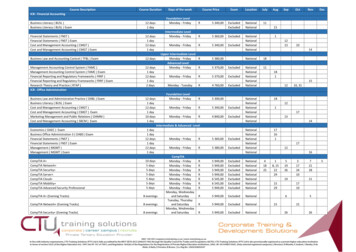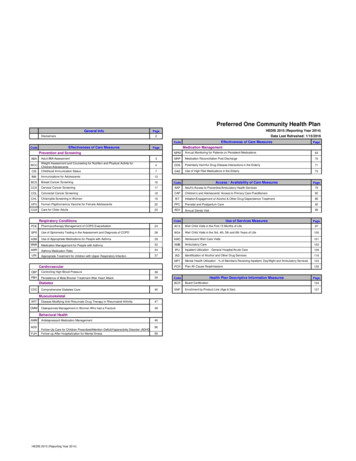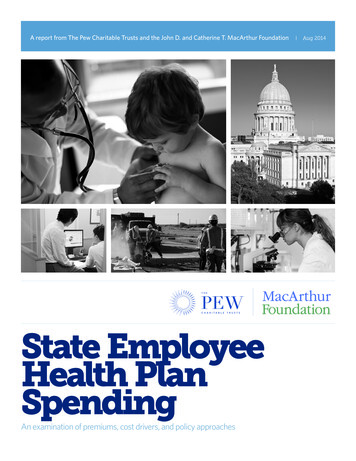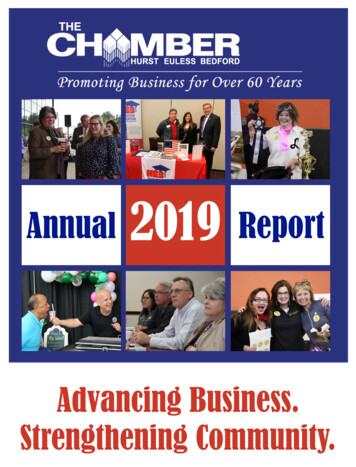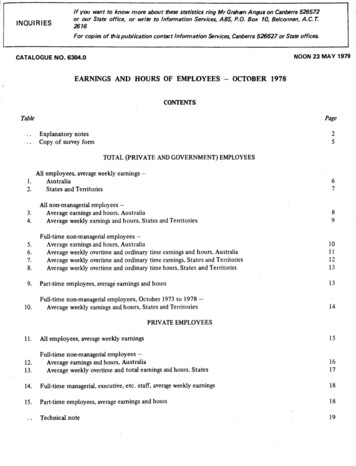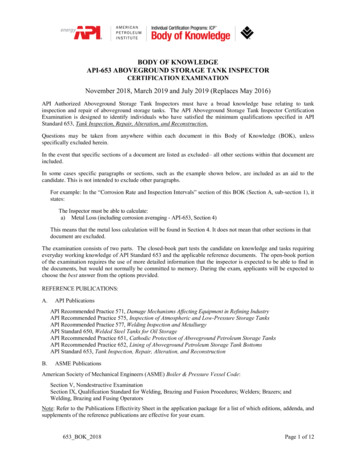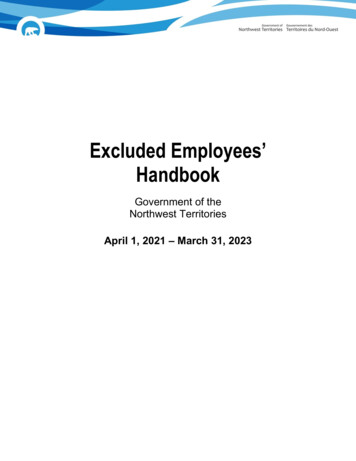
Transcription
Excluded Employees’HandbookGovernment of theNorthwest TerritoriesApril 1, 2021 – March 31, 2023
EXCLUDED EMPLOYEES’ HANDBOOKINTRODUCTIONINTRODUCTIONThe purpose of the Excluded Employees’ Handbook is to describe the terms andconditions of your employment as an excluded employee with the Government of theNorthwest Territories (GNWT).Excluded employees are those employees who are not represented by the Union ofNorthern Workers or the Northwest Territories Teachers’ Association and are not SeniorManagement.These terms and conditions of employment are established by the Public Service Act, thePublic Service Act Regulations, and policies of the Executive Council as amended fromtime to time. It is a term and condition of your employment that changes to thePublic Service Act, Public Service Act Regulations and policies of the Executive Councilamend the terms and conditions of your employment on their effective date. Thoseauthorities prevail if there is any discrepancy between them and the information in thisHandbook. The Handbook will be updated periodically as changes are made. Subject tothe foregoing, the terms of employment in this handbook are effective April 1, 2021 unlessanother date is expressly stated.The Human Resource Manual has operational rules and guidelines for these terms andconditions of employment. If you have any specific questions you should direct them tothe Human Resource Service Centre in your region.The Human Resource Manual and information on your applicable benefits can beaccessed on the GNWT website at:https://my.hr.gov.nt.ca/
EXCLUDED EMPLOYEES’ HANDBOOKTABLE OF CONTENTSTABLE OF CONTENTSDEFINITIONS . 1CONFLICT OF INTEREST. 2OATH OF OFFICE AND SECRECY . 3SMOKE FREE ENVIRONMENT . 3USE OF ELECTRONIC MAIL AND THE INTERNET . 3AFFIRMATIVE ACTION . 3DISCRIMINATION/HARASSMENT . 5PROBATION . 6SALARY . 6Pay for Performance. 7Responsibility Allowance . 7Membership Fees . 8HOURS OF WORK . 8Shift Work . 8Standby . 9Call-Back Pay . 9Shift Premium . 10Weekend Premium . 10Non-Standard Work Schedules . 11Job Share Employees . 11Part-Time Employees . 12Casual Employees. 12Overtime . 12Work on a Designated Paid Holiday . 13i
EXCLUDED EMPLOYEES’ HANDBOOKTABLE OF CONTENTSALLOWANCES . 13Northern Allowance . 13Bilingual Allowance. 15RELOCATION - HIRE/TRANSFER . 15DUTY TRAVEL . 19Transportation . 19Accommodation . 19Meals and Incidental Expenses . 20Other Expenses . 20Travel by Privately Owned Vehicle . 22Headquarters Duty Travel . 23LEAVE. 23Designated Paid Holidays . 24Vacation Leave . 24Winter Bonus Days . 26Sick Leave (With Pay) . 26Special Leave (With Pay) . 27Casual Leave (With Pay) . 28Court Leave (With Pay) . 29Injury On Duty Leave (With Pay) . 29Emergency Leave. 29Leave for Relocation of Your Spouse . 29Mandatory Leave With Pay . 30Maternity Leave . 30Parental Leave Without Pay . 32Parental Leave . 32Caregiving Leave. 33Domestic Violence Leave . 34Self-Funded Leave Plan . 34EDUCATION LEAVE. 35MEDICAL TRAVEL ASSISTANCE . 38Medical Travel - Dental . 39Escort 40Medical Travel Leave . 40ii
EXCLUDED EMPLOYEES’ HANDBOOKTABLE OF CONTENTSPENSION PLAN . 40Public Service Pension Plan . 40HEALTH AND INSURANCE . 40Supplementary Death Benefit . 40Long Term Disability Insurance . 41Employee Duty Travel Accident Insurance . 41Dental Plan . 42Public Service Management Insurance Plan (PSMIP). 43Public Service Health Care Plan (PSHCP) . 43PERFORMANCE EVALUATION . 44JOB EVALUATION. 44INDEMNIFICATION . 45GRIEVANCE PROCESS. 45SEVERANCE PAY . 46Lay-Off . 46Resignation. 47Retirement . 48Death 49Dismissal, Abandonment of Position . 49REMOVAL ON TERMINATION . 49Maximum Reimbursement Schedule . 50Payment of Ultimate Removal Assistance. 51TERMINATION . 51SALARY GRIDS . 52HOURLY RATES OF PAY. 52Effective April 1, 2021 . 52Effective April 1, 2022 . 53iii
EXCLUDED EMPLOYEES’ HANDBOOKDEFINITIONSContinuous ServiceUninterrupted employment: with the Government of the Northwest Territories; including prior service with the Public Service of the Government of Canada, if youwere hired or transferred within three months. This does not apply when a functionis transferred to the Government of the Northwest Territories; including prior service with the municipalities and hamlets of the NorthwestTerritories if you were hired or transferred within three months; including prior service with the Hay River Health and Social Services Authority,providing an employee was recruited or transferred within three (3) months ofterminating their previous employment. Continuous Service for the purposes ofGNWT severance pay under this handbook will not include any periods ofemployment with Hay River Health and Social Services Authority for whichseverance was paid. if you were re-appointed after being laid off, employment in the position held at thetime of your lay-off is included, if the lay-off was after April 1, 1970; if you were re-employed (other than as a casual) by the Government within threemonths, employment in the position held at the time of termination will be included.This does not apply if you were dismissed, you abandoned the position or you wererejected on probation.DependentAny person living with you who is: your spouse, whether or not currently residing together; your child, step-child, adopted child or foster child who is:-under 21 years old and dependent on you for support; or-21 years old or older and is dependent on you because of mental or physicalillness.1
EXCLUDED EMPLOYEES’ HANDBOOK a relative who is wholly dependent on you for support because of mental orphysical illness.To live with you means to live in the same dwelling. Normally this will be where the personreceives mail, keeps personal property and spends the majority of time.EmployeeAn employee of the Government, other than an employee of the Northwest TerritoriesPower Corporation or a teacher, who is ineligible for membership in a bargaining unit,pursuant to the Public Service Act.EmployerThe Government of the Northwest Territories as represented by the Minister Responsiblefor the Public Service or designate.Lay-OffAn employee whose employment has been terminated because of lack of work orbecause of the discontinuance of a function and who is suitable for continued employmentin the Public Service. Lay-off does not mean an employee whose employment has beenterminated because of a transfer of the work or function to another employer where theemployee is offered employment with the new employer.SpouseA person, regardless of gender who: is married to you, or has lived together in a conjugal relationship outside of marriage with you and yourepresent that person as your spouse.CONFLICT OF INTERESTYou must adhere to and comply with the provisions of the Code of Conduct RespectingConflict of Interest and Oath of Office and Secrecy and any amendments that may be madeto it from time to time.2
EXCLUDED EMPLOYEES’ HANDBOOKOATH OF OFFICE AND SECRECYYou must take the following oath:I, (.), solemnly and sincerely swear that I will faithfully and honestly fulfil the duties thatdevolve upon me by reason of my employment in the Public Service of the NorthwestTerritories and that I will not, without due authority, disclose or make known any matter thatcomes to my knowledge by reason of such employment. So help me God.ORIf you object to taking an oath, you must make the following affirmation:I, (.), solemnly affirm that I will faithfully and honestly fulfil the duties that devolve upon meby reason of my employment in the Public Service of the Northwest Territories and that I willnot, without due authority, disclose or make known any matter that comes to my knowledgeby reason of such employment.SMOKE FREE ENVIRONMENTA smoke free environment is provided.USE OF ELECTRONIC MAIL AND THE INTERNETYou must ensure you are familiar with and adhere to the GNWT policies entitled “E-mailUse Policy, Internet Use Policy, and Mobile Handheld Device Policy understanding thatif you fail to abide by the terms and conditions of these policies, you may be subject todisciplinary action, up to and including dismissal.AFFIRMATIVE ACTIONThe Government is committed to achieving a representative workforce. When theGovernment hires, people belonging to certain designated groups are given priority. Thepriority ranges from #1 (highest) to #4 (lowest). There are different priorities depending onthe type of job.For management and non-traditional jobs, the priorities are:1a.1b.Indigenous Aboriginal female personsIndigenous Aboriginal male persons3
EXCLUDED EMPLOYEES’ HANDBOOK2.3.4.Resident womenIndigenous Non-Aboriginal persons or Resident Disabled personsAll other applicantsFor all other jobs, the priorities are:1.2.3.Indigenous Aboriginal personsIndigenous Non-Aboriginal persons or Resident Disabled personsAll other applicantsIndigenous Aboriginal Persons are those persons who are descendants of the Dene,Inuit or Métis people, indigenous to the present boundaries of the Northwest Territoriesand include any aboriginal persons resident at birth pursuant to Section 7.1 of the VitalStatistics Act and any Canadian aboriginal persons who have lived more than half of theirlives in the Northwest Territories.Indigenous Non-Aboriginal Persons are non-aboriginal persons born in the NorthwestTerritories or who have lived more than half their lives in the Northwest Territories.Resident Women are women who are living in and have lived in the Northwest Territoriesfor at least one year immediately prior to applying on a competition.Resident Disabled Persons are persons who are living in and have lived in the NorthwestTerritories for at least one year immediately prior to applying on a competition and whoare at a disadvantage because of a medically certified learning, mental, emotional, orphysical disability where the disability handicaps the person in taking advantage ofemployment, training and career advancement opportunities. A person without such adisability would not encounter these difficulties.Physical disabilities may be visible or non-visible. They may include any degree ofparalysis, amputation, lack of physical co-ordination, blindness or visual impairment,deafness or hearing impairment, muteness or speech impairment, or physical reliance ona guide dog, a wheelchair or other appliances or devices. Learning, mental or psychiatricdisabilities may include learning or comprehension incapacities, which are significant andpersistent but permit the disabled individual to carry out duties and perform tasks in areliable manner under a reasonable amount of supervision.For these purposes, Management Positions are positions within the Senior ManagementGroup including Deputy Ministers, Assistant Deputy Ministers, Superintendents, Directorsand Chief Executive Officers, where all the positions included in this group are determinedby the Department of Finance.Non-Traditional Occupations are occupations where 70% or more of the incumbents aremale and there are ten or more incumbents in an occupational category orsub-group as determined by the Department of Finance.4
EXCLUDED EMPLOYEES’ HANDBOOKYou can only include yourself in one priority group. For example, you will not get extraconsideration for being an aboriginal, resident female.DISCRIMINATION/HARASSMENTThe Government is committed to providing a workplace free of discrimination, interference,restriction, harassment or coercion exercised or practiced with respect to any employee byreason of age, sex, race, colour, creed, national or ethnic origin, marital status, family status,sexual orientation, gender identity, gender expression, disability, conviction for which apardon has been granted, religious or political affiliation, or any other grounds proscribed byapplicable legislation.A discriminatory employment practice is one in which an employer: refuses to employ or continue to employ any individual on any ground or groundslisted above; or in the course of employment, differentiates adversely in relation to an employee onany ground or grounds listed above.It is not a discriminatory practice to have a special program, for example, the GovernmentAffirmative Action Program, which is designed to correct historical disadvantages.Harassment Free and Respectful Workplace PolicyAs set out in the Harassment Free and Respectful Workplace Policy, the Governmentrecognizes the diversity of the Public Service and is committed to providing a workenvironment where all individuals are treated with fairness, dignity and respect. TheGovernment endeavours to have a workplace free from personal harassment, sexualharassment, and the abuse of authority.Harassment includes any improper conduct, comment or display directed at anotheremployee and that a reasonable person would know is unwelcome. It comprisesobjectionable conduct, comment or display made on either a one-time or continuousbasis, that demeans, belittles, or causes personal humiliation or embarrassment to anemployee. Harassment includes a poisoned environment where offensive conduct orcomments, not necessarily directed at anyone in particular, are pervasive, and have anegative effect on morale.Sexual harassment means any conduct, comment, gesture or contact of a sexual nature,whether on a one-time basis or in a continuous series of incidents that might reasonablybe expected to cause offence or humiliation to any employee; or that the employee might5
EXCLUDED EMPLOYEES’ HANDBOOKreasonably perceive as placing a condition of a sexual nature on employment or on anopportunity for training or promotion.Abuse of Authority is a form of harassment which occurs when an individual improperlyuses the power and authority inherent in their position to endanger an employee’s job,undermine the performance of that job, threaten the economic livelihood of the employee,or in any way interfere with or influence the career of the employee. It includesintimidation, threats, blackmail or coercion.PROBATIONProbationary periods are an opportunity to learn if you are suitable for the position to whichyou have been appointed.Your probationary period begins on the first day in your position and lasts: six months, if you are transferred or promoted to another position in the PublicService six months if you are transferred or appointed to a position below Pay Range 13 one year if you are appointed to a position at or above Pay Range 13.Employees are not required to serve additional probationary periods when appointed to aposition which has the same duties as the previous position.Extension of a probationary period may be approved at the Superintendent/Director level.SALARYYou are paid based on the point value of your job, as determined by the Korn Ferry JobEvaluation System (formally known as Hay). Hourly salaries for each point range areincluded in Appendix A.If you are hired within two (2) years of your last date of employment with the Employer toperform the same duties, you shall be paid at the same step as you were being paid whenyou ceased to be an employee. This does not apply to casual employees.If you are a newly appointed employee or are the successful employee in a competition fora new job, you will be placed on step 2 of the applicable pay range of your position if youhave two (2) years of directly related experience to the responsibilities of the new job; atstep 3 if you have more than two (2) but less than four (4) years of directly related experience6
EXCLUDED EMPLOYEES’ HANDBOOKto the responsibilities of the new job; and step 4 if you have more than four (4) years ofdirectly related experience to the responsibilities of the new job.Pay increments are granted in recognition of service and good performance.Pay increments, which are recommended by the Deputy Head, shall be granted the first dayof the month of the employee’s initial appointment.Salary increment dates for employees on education leave or leave without pay arepostponed until 12 months of full-time work from the previous pay increment have beencompleted.Salary is paid every other week. Your bi-weekly salary is calculated by multiplying yourbase salary (hourly rate in Appendix A) by the number of hours you are scheduled to workin a two-week period (75 or 80). Upon initial hire, one week of your base salary will bewithheld and you will be paid one week in arrears until the termination of youremployment.Pay for PerformanceIf your contributions and achievements during the year are outstanding, you may receive: A one-time Pay for Performance bonus of up to a maximum of 3.5% to reflect thedegree to which expected levels of achievements and contributions are exceeded asprovided for in the Performance Development Program.Except in exceptional circumstances, Pay for Performance will not be awarded where theemployee does not have a completed performance appraisal for the applicable fiscal year.Responsibility AllowanceEmployees receive a responsibility allowance for temporarily performing the duties of ahigher position.When you are required to temporarily perform the duties of a position at a higher pay range: for five (5) days or less, you will receive a responsibility allowance equal to 10% of yourbase salary; for more than five (5) days, you will receive a responsibility allowance equal to 12% ofyour base salary.If your increment falls within the acting period, it will be applied in the acting category.7
EXCLUDED EMPLOYEES’ HANDBOOKMembership FeesThe Employer shall reimburse an employee or on behalf of the employee, pay formembership, registration, licensing or certification fees to an organization, governingbody, or government agency when the payment of such fees is a requirement for theperformance of the duties of the employee’s position.HOURS OF WORKThe standard hours of work for employees are either 8 hours a day (40 hours a week) or7.5 hours a day (37.5 hours a week). This is usually worked between 08:00 or 08:30 and17:00, Monday to Friday inclusive. There is a paid 15-minute break in the morning and apaid 15-minute break in the afternoon.Employees in some occupational groups are required to work shifts where their days of restmay be other than Saturday and Sunday, or their hours may be other than the standardhours.You must make every reasonable effort to notify your supervisor at your regular start time ifyou are unable to report for work for whatever reason. You must provide reasonablenotification and get approval from your supervisor for any anticipated absence from yourworkplace.If you are absent without approval, you may be subject to disciplinary action, and adeduction from your pay may be made.Shift WorkThe Government sets up a regular schedule of hours of work for employees in occupationalgroups that require shift work. A master weekly shift schedule will be posted 14 days inadvance to cover the work area's shift requirements for 28 calendar days.You will be granted alternate weekends off as often as reasonably possible. If you areworking for a third consecutive weekend, you will be paid the overtime rate for that weekendand any subsequent consecutive weekends afterwards. This does not apply to employeeswho are hired exclusively to work weekends or who request to exchange shifts with otheremployees to work weekends.The Government will make every reasonable effort to schedule your shifts to allow you toregularly attend educational courses.8
EXCLUDED EMPLOYEES’ HANDBOOKIf you are scheduled to work between midnight and 06:00 or are required to travel duringthese hours to perform overtime work, the Government will provide transportation or the costof commercial transportation between your home and the workplace.Employees may exchange shifts with management approval.StandbyStandby is where you must be available during off duty hours and have been placed onstandby status. You will be paid one hours pay at your base salary for each eight (8)consecutive hours or portion thereof that you are on standby. If you are on standby on aday of rest or a designated paid holiday, you will be paid one and one-half hours pay at yourbase salary for each eight (8) consecutive hours or portion thereof that you are on standby.When you are on standby and you are required to return to the workplace, you will be paidat the appropriate overtime rate with a minimum of four hours pay at the straight time rate.Each following call to report to work during the same eight-hour period will be at theappropriate overtime rate for the actual hours worked.When you report to work during standby, and are required to use transportation servicesother than the normal public transportation service, you will be paid the actual cost ofcommercial transportation each way. You must provide receipts for payment oftransportation costs over ten dollars ( 10). If you use your personal motor vehicle, you willbe paid the appropriate distance rates specified in the Duty Travel Section of this handbook.When you are on standby and you are required to work by responding by phone, email orother electronic means and are not required to return to the workplace, you will becompensated at the greater of: One (1) hour at the straight time rate; orCompensation at the applicable overtime rate for time worked.The minimum one hour payment applies only once during each sixty minute period.The minimum payment of one hour at the overtime rate, as specified in the Overtime sectionof this handbook, does not apply.If you are on standby, you are not entitled to Call-Back Pay.Call-Back PayCall-Back is when you are recalled by the Employer to a place of work for a specific duty.You will be compensated the greater of:9
EXCLUDED EMPLOYEES’ HANDBOOK Compensation at the appropriate overtime rate; orCompensation equivalent to four (4) hours pay at the straight-time rate.When you report to work as a Call-Back, and are required to use transportation servicesother than the normal public transportation service, you will be paid the actual cost ofcommercial transportation each way. You must provide receipts for payment oftransportation costs over ten dollars ( 10). If you use your personal motor vehicle, you willbe paid the appropriate distance rates specified in the Duty Travel Section of this handbook.If you are required to work during off duty hours by responding by phone, email or otherelectronic means and are not required to return to the workplace, you will be compensatedat the greater of: One (1) hour at the straight time rate; orCompensation at the applicable overtime rate for time worked.The minimum one hour payment applies only once during each sixty minute period.The minimum payment of one hour at the overtime rate, as specified in the Overtime sectionof this handbook, does not apply.If you receive pay under this article
These terms and conditions of employment are established by the Public Service Act, the Public Service Act Regulations, and policies of the Executive Council as amended from time to time. It is a term and condition of your employment that changes to the Public Service Act, Public Service Act Regulations and policies of the Executive Council
